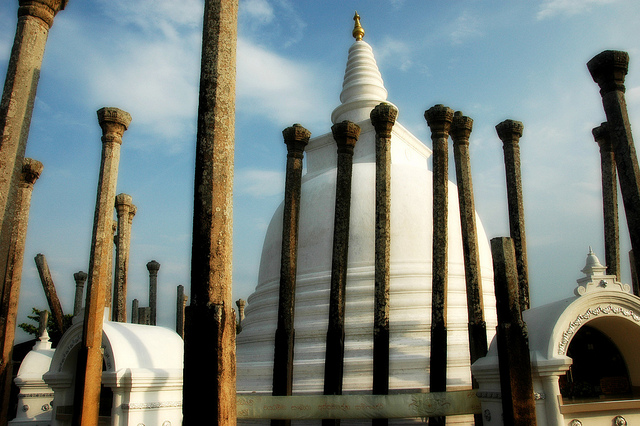The well-known first historical archaeological terrain and medieval metropolis of Sri Lanka – Anuradhapura has a spiritual and temporal value for a sheer blend of Mauryan architectural skill surpassing Egyptian graves, tombs, and monuments flourishing as astounding constructions of hydraulic engineering marvels, gargantuan monasteries which paralyze tourists’ eye sockets.
From 300 BC to 997 AD Anuradhapura envelops the great history enclosing an indefinite number of archaeological achievements – Brazen Palace, Ruwanweliseya, King Mahasen’s palace, Abhayagiri dagoba – the second biggest brick construction in the world; Kuttam Pokuna – The twin pond – Under earth terracotta pipe network for tank water supply; the Samadhi Buddha statue – the Buddha on concentration, the Moonstone, the redemption representation of the Sansaric Circle; the sacred Bo sapling- Ficus religiose aging over 2000 years; Lankaramaya – the one and only stupa in the form of the fruit of Nelli – Phyllanthus Emblica; the Jethawana Stupa – several gigantic refectories for aspirant arahats; Mirisawetiya dagoba, Tuparama Stupa, Basawakkulam tank – the first tank in Sri Lanka and many more bewitching sites which discourage or delay your homeward journey from Sri Lanka.
The ancient hydraulic network of constructions such as spillways, cisterns, sluices, and long canals with minimal possible slopes have been built down the ages in the form of great tanks like the Thissa tank, the Sea of Parakrama, the Minneriya tank, Kalawewa which are ever reminiscent of stalwart engineering masterpieces with no defects.
a. Mahavihara– The oldest city monastery erected by King Devanampiyatissa is visible with dotted and sparse remnants of buildings.
b. The Sacred Bo Tree– The most venerated Bo tree which helped attain the Enlightenment of the Aspirant Buddha stands at high elevation. The access is through a series of terraces and golden railings. It’s worthwhile eyeing on while devout pilgrims with religious sanctity flock round to vow their offerings meeting with the traditionally and customarily dedicated inhabitants of Viharapalugama adorned in the so-called specific white attire with a turban.
c. Brazen Palace– The Lovamahapaya- a Stonehenge – a believable hyperbole of nine storied buildings on stone pillars as the Mahavansa- the ancient chronicle of Sri Lanka says was the abode for Buddhist priests. The salvaged structure remains impervious to other monuments.
d. Ruwanweliseya – 55m high massive Stupa in which remains of the Buddha have been enshrined in the form of a bowl of relics is very busy with many white-clad and barefoot pilgrims. The foreigners are transfixed on the relief carvings of elephants flanked by Nagarjuna Guard stones, frontispieces to mark cardinal points, friezes decorated with lions, bulls, tiaras holding lotuses, magnificent moonstones at entrances, balustrades carved with deer, monkeys, hermits, and lions which are harmoniously placed to bring about Buddhist perspective of loving-kindness to animals.
e. Jethawana Monastery – The hermitage reclaimed from rivals was the center of Theravada doctrine built by King Mahasen 274-301.
f. The Jethavana Dagoba – This overwhelming edifice stood 120m high in its initial structure was second to the Giza pyramid in Egypt. The Victorian civil servant and archaeologist Emerson Tennant says the number of red bricks used in this construction can be used to build a parapet of 3m high from London to Edinburgh. The historical presumption is not yet known to anyone that why such a colossal construction was built. Having lost the towering portion of the Jethawana Stupa, it stands 70m high, studded with eroded elephant heads, unidentified goddess, flanked by the monastery with a preserved bathing pool, latticed Buddhist railings, chapter houses, a reliquary placed with relics and cameo statues.
g. Jethawana Museum – It depicts the glory of the pristine life of Anuradhapura consisting of fragments of mythical carvings on friezes, guard stones, ornaments like beads, necklaces, bangles, gold jewelry, precious and semi-precious stones, urinal pots, and many more ingots of secularity and spirituality.
h. The Royal Alms Hall- The refectory built by the king Vijayabahu 1 in 1070, guard stone with dwarfs in relief, Royal Palace, impressively stepped Temple of Tooth- the brick Gedige are some unique creations in the citadel.
i. Abhayagiri Monastery- The king Walagamba in 88 BC built this artistic creation defying the Jain denomination. The prodigious remains of this lost history fans’ pleasure and leisure in serendipity laced with fear and respect. The museum built there accounts for the far-reaching contacts of Buddhist ties with Java, Burma, China, and India, it had.
j. Abhayagiri Dagoba- The second tallest edifice in the ancient world built by Walagamba formerly stood up to 115m high, but now inherits 75mowing to the loss of its pinnacle. The dazzling imaginative picture of this fuzzy argosy of earth cone looks like a massive construction site with a maze of scaffolding. Awaiting unexpected wealth and health, a continual queue of theists of polytheism vows the flanking statues of Padmanidhi and Sankanidhi- the dwarfish attendants of Kuvera- the God of wealth.
Grecian chalices, classical tracery of flora and fauna symbolize wisdom training through medieval Renaissance when you pace through the Wahalkada – frontispieces which are supporting the diastolic pressure of the piled earth.
k. Samadhi Statue – It is no doubt that why you have visited this UNESCO city when you are at the Samadhi Buddha of limestone because the Buddha in meditation posture with eyes studded with gems disciplines you into the concentration of mind and physique.
l. Isurumuniya – The historical controversial love couple that resides in Isurumuni museum is believed to be the prince Saliya and the princess Asokamala – the low caste girl who fell in love, low relief carving of elephants on the mother rock embellishes the artistic prosperity at the regime of the king Devanampiyatissa in Anuradhapura.
















No Comments on Anuradhapura